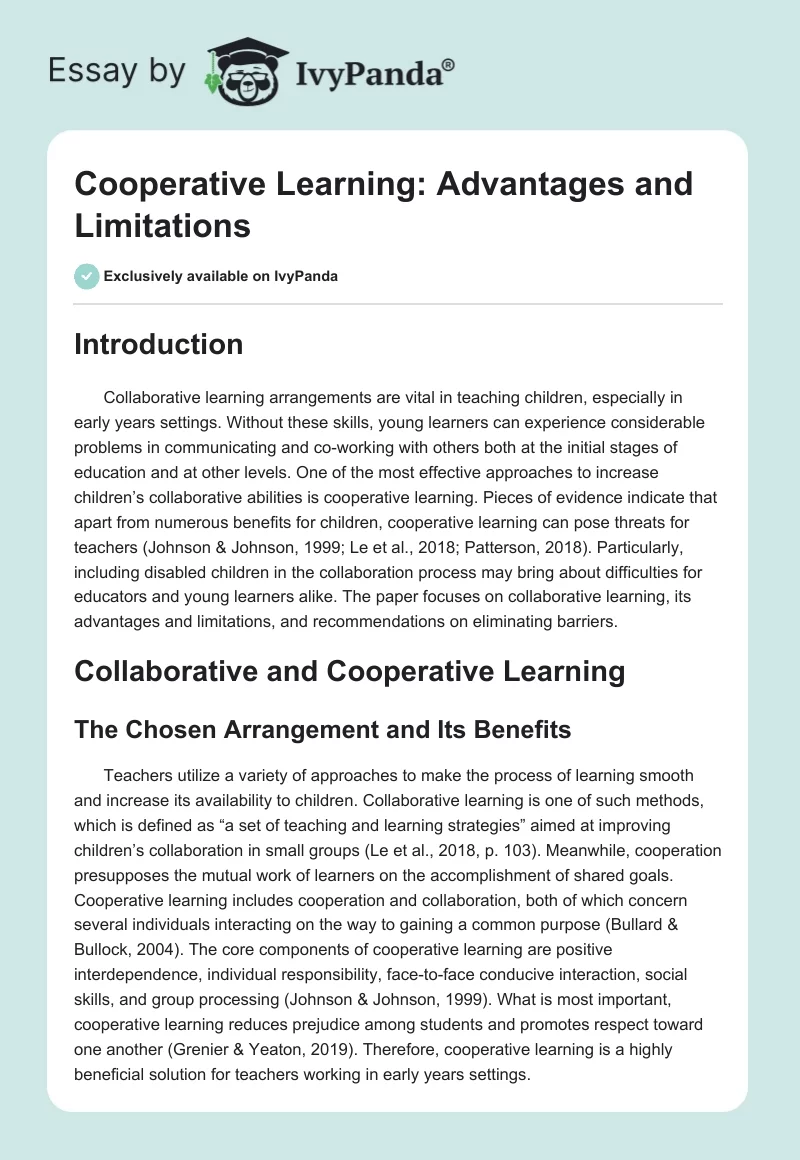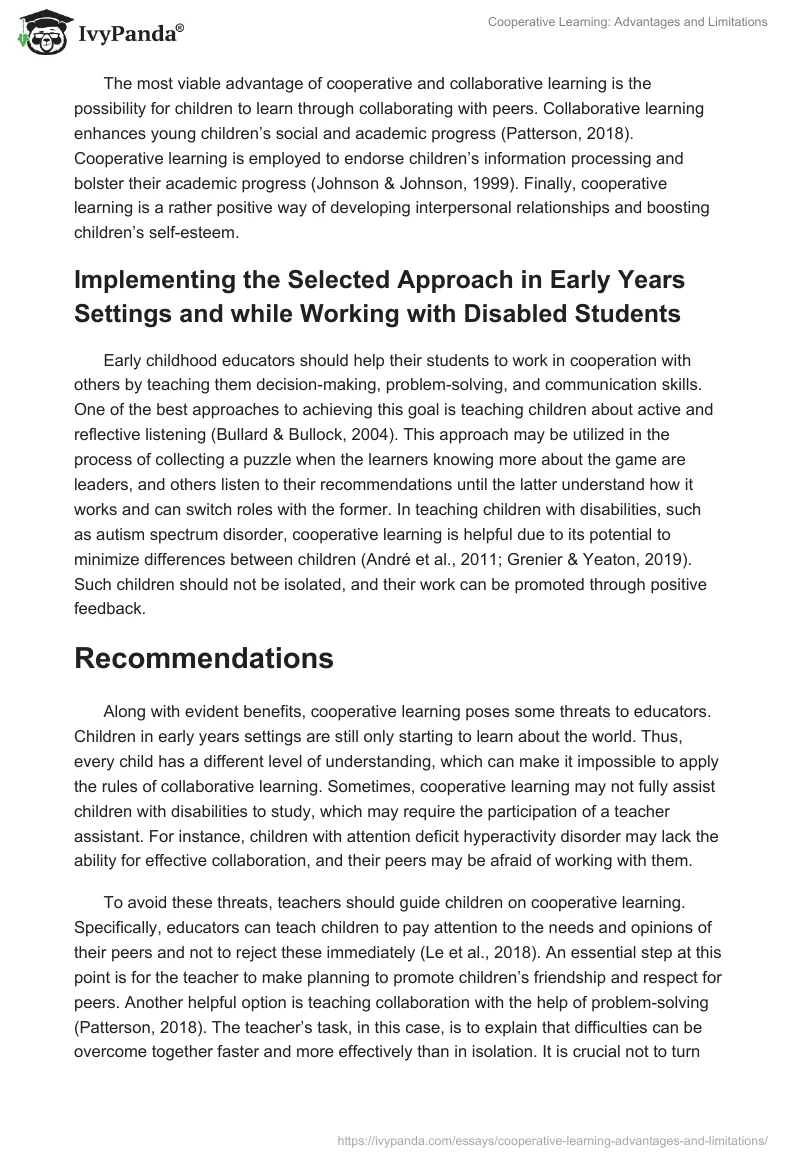Introduction
Collaborative learning arrangements are vital in teaching children, especially in early years settings. Without these skills, young learners can experience considerable problems in communicating and co-working with others both at the initial stages of education and at other levels.
One of the most effective approaches to increase children’s collaborative abilities is cooperative learning. Pieces of evidence indicate that apart from numerous benefits for children, cooperative learning can pose threats for teachers (Johnson & Johnson, 1999; Le et al., 2018; Patterson, 2018). Particularly, including disabled children in the collaboration process may bring about difficulties for educators and young learners alike. The paper focuses on collaborative learning, its advantages and limitations, and recommendations on eliminating barriers.
Collaborative and Cooperative Learning
The Chosen Arrangement and Its Benefits
Teachers utilize a variety of approaches to make the process of learning smooth and increase its availability to children. Collaborative learning is one of such methods, which is defined as “a set of teaching and learning strategies” aimed at improving children’s collaboration in small groups (Le et al., 2018, p. 103). Meanwhile, cooperation presupposes the mutual work of learners on the accomplishment of shared goals. Cooperative learning includes cooperation and collaboration, both of which concern several individuals interacting on the way to gaining a common purpose (Bullard & Bullock, 2004).
The core components of cooperative learning are positive interdependence, individual responsibility, face-to-face conducive interaction, social skills, and group processing (Johnson & Johnson, 1999). What is most important, cooperative learning reduces prejudice among students and promotes respect toward one another (Grenier & Yeaton, 2019). Therefore, cooperative learning is a highly beneficial solution for teachers working in early years settings.
The most viable advantage of cooperative and collaborative learning is the possibility for children to learn through collaborating with peers. Collaborative learning enhances young children’s social and academic progress (Patterson, 2018). Cooperative learning is employed to endorse children’s information processing and bolster their academic progress (Johnson & Johnson, 1999). Finally, cooperative learning is a rather positive way of developing interpersonal relationships and boosting children’s self-esteem.
Implementing the Selected Approach in Early Years Settings and while Working with Disabled Students
Early childhood educators should help their students to work in cooperation with others by teaching them decision-making, problem-solving, and communication skills. One of the best approaches to achieving this goal is teaching children about active and reflective listening (Bullard & Bullock, 2004). This approach may be utilized in the process of collecting a puzzle when the learners knowing more about the game are leaders, and others listen to their recommendations until the latter understand how it works and can switch roles with the former.
In teaching children with disabilities, such as autism spectrum disorder, cooperative learning is helpful due to its potential to minimize differences between children (André et al., 2011; Grenier & Yeaton, 2019). Such children should not be isolated, and their work can be promoted through positive feedback.
Recommendations
Along with evident benefits, cooperative learning poses some threats to educators. Children in early years settings are still only starting to learn about the world. Thus, every child has a different level of understanding, which can make it impossible to apply the rules of collaborative learning. Sometimes, cooperative learning may not fully assist children with disabilities to study, which may require the participation of a teacher assistant. For instance, children with attention deficit hyperactivity disorder may lack the ability for effective collaboration, and their peers may be afraid of working with them.
To avoid these threats, teachers should guide children on cooperative learning. Specifically, educators can teach children to pay attention to the needs and opinions of their peers and not to reject these immediately (Le et al., 2018). An essential step at this point is for the teacher to make planning to promote children’s friendship and respect for peers. Another helpful option is teaching collaboration with the help of problem-solving (Patterson, 2018).
The teacher’s task, in this case, is to explain that difficulties can be overcome together faster and more effectively than in isolation. It is crucial not to turn the attempt into pseudo learning, where children do not have a sincere interest in gaining mutual goals (Johnson & Johnson, 1999). Educators can also increase learners’ interpersonal and group skills by offering assistance, which will increase their social and cognitive skills. Finally, a regular assessment is needed to see how students progress and what help they might require on the way to boosting collaborative learning skills.
Conclusion
Collaborative learning is viewed as a highly positive approach to increasing young learners’ communication and integration skills. Collaboration is especially useful to employ with the aim of including disabled children in the learning process. Although it is not always easy to arrange the approach smoothly, so, a thorough plan and keen observation, as well as assistance from another teacher or specialist can be of great help.
Once a teacher realizes how to avoid common mistakes in the implementation and practicing of collaborative learning, this approach will serve as an invaluable way of teaching all children, irrespective of their social or physical disability issues, to be attentive, helpful, and respectful toward one another.
References
André, A., Deneuve, P., & Louvet, B. (2011). Cooperative learning in physical education and acceptance of students with learning disabilities. Journal of Applied Sport Psychology, 23(4), 474-485.
Bullard, J., & Bullock, J. R. (2004). Building relationships through cooperative learning. Journal of Early Childhood Teacher Education, 25(1), 39-48.
Grenier, M., & Yeaton, P. (2019). Social thinking skills and cooperative learning for students with autism. Journal of Physical Education, Recreation & Dance, 90(3), 18-21.
Johnson, D. W., & Johnson, R. T. (1999). Making cooperative learning work. Theory into Practice, 38(2), 67-73.
Le, H., Janssen, J., & Wubbels, T. (2018). Collaborative learning practices: Teacher and student perceived obstacles to effective student collaboration. Cambridge Journal of Education, 48(1), 103-122.
Patterson, E. W. (2018). Exploratory talk in the early years: Analysing exploratory talk in collaborative group activities involving younger learners. Education 3-13, 46(3), 264-276.


